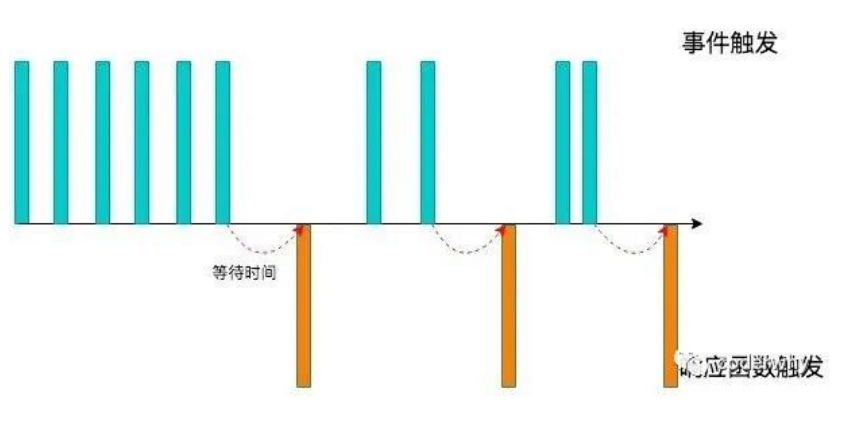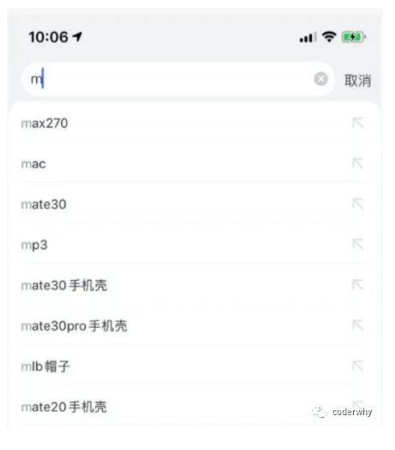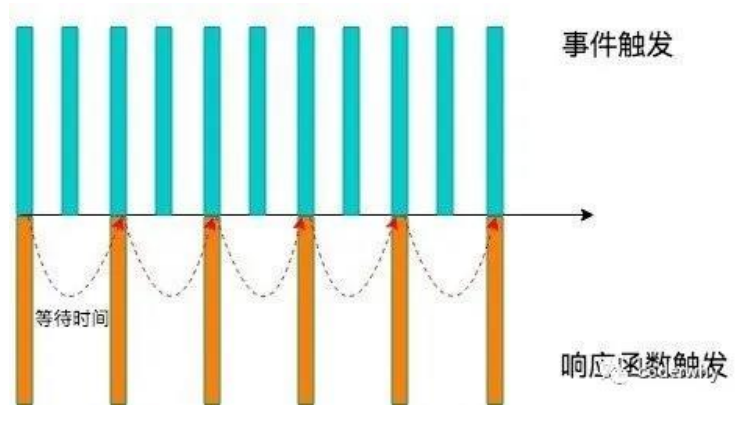一. 认识防抖和节流
1. 认识防抖和节流函数
- 防抖和节流的概念其实最早并不是出现在软件工程中,防抖是出现在电子元件中,节流出现在流体流动中
- 而
js是事件驱动的,大量的操作会触发事件,加入到事件队列中处理 - 而对于某些频繁的事件处理会造成性能的损耗,我们就可以通过防抖和节流来限制事件频繁的发生
- 而
- 防抖和节流函数目前已经是前端实际开发中两个非常重要的函数,也是面试经常被问到的面试
- 但是很多前端开发者面对这两个功能,有点摸不着头脑:
- 某些开发者根本无法区分防抖和节流有什么区别(面试经常会被问到)
- 某些开发者可以区分,但是不知道如何应用
- 某些开发者会通过一些第三方库来使用,但是不知道内部原理,更不会编写
- 接下来我们会一起来学习防抖和节流函数:
- 我们不仅仅要区分清楚防抖和节流两者的区别,也要明白在实际工作中哪些场景会用到
- 并且我会带着大家一点点来编写一个自己的防抖和节流的函数,不仅理解原理,也学会自己来编写
2. 认识防抖 debounce 函数
我们用一副图来理解一下它的过程:
- 当事件触发时,相应的函数并不会立即触发,而是会等待一定的时间
- 当事件密集触发时,函数的触发会被频繁的推迟
- 只有等待了一段时间也没有事件触发,才会真正的执行响应函数

防抖的应用场景很多:
- 输入框中频繁的输入内容,搜索或者提交信息
- 频繁的点击按钮,触发某个事件
- 监听浏览器滚动事件,完成某些特定操作
- 用户缩放浏览器的
resize事件
3. 防抖函数的案例
我们都遇到过这样的场景,在某个搜索框中输入自己想要搜索的内容:
比如想要搜索一个
MacBook:- 当我输入
m时,为了更好的用户体验,通常会出现对应的联想内容,这些联想内容通常是保存在服务器的,所以需要一次网络请求 - 当继续输入
ma时,再次发送网络请求 - 那么
macbook一共需要发送7次网络请求 - 这大大损耗我们整个系统的性能,无论是前端的事件处理,还是对于服务器的压力

- 当我输入
但是我们需要这么多次的网络请求吗?
- 不需要,正确的做法应该是在合适的情况下再发送网络请求
- 比如如果用户快速的输入一个
macbook,那么只是发送一次网络请求 - 比如如果用户是输入一个
m想了一会儿,这个时候m确实应该发送一次网络请求 - 也就是我们应该监听用户在某个时间,比如
500ms内,没有再次触发时间时,再发送网络请求
这就是防抖的操作:在指定的时间内,没有再次触发时,才去执行对应的操作
4. 认识节流 throttle 函数
我们用一副图来理解一下节流的过程
- 当事件触发时,会执行这个事件的响应函数
- 如果这个事件会被频繁触发,那么节流函数会按照一定的频率来执行函数
- 不管在这个中间有多少次触发这个事件,执行函数的频繁总是固定的
节流:在频繁触发的时候,只会按照固定的时间间隔去执行对应的操作

节流的应用场景:
- 监听页面的滚动事件
- 鼠标移动事件
- 用户频繁点击按钮操作
- 游戏中的一些设计
5. 节流函数的应用场景
很多人都玩过类似于飞机大战的游戏
在飞机大战的游戏中,我们按下空格会发射一个子弹:
- 很多飞机大战的游戏中会有这样的设定,即使按下的频率非常快,子弹也会保持一定的频率来发射
- 比如1秒钟只能发射一次,即使用户在这1秒钟按下了10次,子弹会保持发射一颗的频率来发射
- 但是事件是触发了10次的,响应的函数只触发了一次

6. 生活中的例子:防抖和节流
- 生活中防抖的例子:
- 比如说有一天我上完课,我说大家有什么问题来问我,我会等待五分钟的时间
- 如果在五分钟的时间内,没有同学问我问题,那么我就下课了
- 在此期间,a同学过来问问题,并且帮他解答,解答完后,我会再次等待五分钟的时间看有没有其他同学问问题
- 如果我等待超过了5分钟,就点击了下课(才真正执行这个时间)
- 生活中节流的例子:
- 比如说有一天我上完课,我说大家有什么问题来问我,但是在一个5分钟之内,不管有多少同学来问问题,我只会解答一个问题
- 如果在解答完一个问题后,5分钟之后还没有同学问问题,那么就下课
7. 案例准备
- 我们通过一个搜索框来延迟防抖函数的实现过程:
- 监听
input的输入,通过打印模拟网络请求
- 监听
- 测试发现快速输入一个
macbook共发送了7次请求,显示我们需要对它进行防抖操作:

二. underscore 库的使用
1. underscore 库的介绍
事实上我们可以通过一些第三方库来实现防抖操作:
lodash、underscore
这里使用
underscore- 我们可以理解成
lodash是underscore的升级版,它更重量级,功能也更多 - 但是目前看
underscore还在维护,lodash已经很久没有更新了
- 我们可以理解成
Underscore的官网:https://underscorejs.org/Underscore的安装有很多种方式:- 下载
Underscore,本地引入 - 通过
CDN直接引入 - 通过包管理工具(
npm)管理安装
- 下载
这里我们直接通过
CDN:html<script src="https://cdn.jsdelivr.net/npm/underscore@1.13.1/underscore-umd-min.js"></script>
2. underscore 实现防抖和节流
html
<input type="text">
<script src="https://cdn.jsdelivr.net/npm/underscore@1.13.1/underscore-umd-min.js"></script>
<script>
const inputEl = document.querySelector('input')
const inputChange = function() {
console.log('value: ', this.value)
}
// 实现防抖
inputEl.oninput = _.debounce(inputChange, 1000)
// 实现节流
inputEl.oninput = _.throttle(inputChange, 1000)
</script>三. 防抖函数实现及优化
1. 基本实现
js
function laterDebounce(fn, delay) {
// 1.用于记录上一次事件触发的timer
let timer = null
// 2.触发事件时执行的函数
const _debounce = function() {
// 2.1.如果有再次触发(更多次触发)事件, 那么取消上一次的事件
if (timer) clearTimeout(timer)
// 2.2.延迟去执行对应的fn函数(传入的回调函数)
timer = setTimeout(function() {
fn()
timer = null // 执行过函数之后, 将timer重新置null
}, delay)
}
// 返回一个新的函数
return _debounce
}
const inputEl = document.querySelector('input')
const inputChange = function() {
console.log('发送请求' + +new Date())
}
// 实现防抖
inputEl.oninput = laterDebounce(inputChange, 1000)2. this 和参数实现绑定
js
function laterDebounce(fn, delay) {
// 1.用于记录上一次事件触发的timer
let timer = null
// 2.触发事件时执行的函数
const _debounce = function(...args) { // 接受多个参数
// 2.1.如果有再次触发(更多次触发)事件, 那么取消上一次的事件
if (timer) clearTimeout(timer)
// 2.2.延迟去执行对应的fn函数(传入的回调函数)
timer = setTimeout(() => { // 使用箭头函数绑定上层this
fn.apply(this, args)
timer = null // 执行过函数之后, 将timer重新置null
}, delay)
}
// 返回一个新的函数
return _debounce
}
const inputEl = document.querySelector('input')
const inputChange = function(event) {
console.log('value: ' + this.value, event)
}
// 实现防抖
inputEl.oninput = laterDebounce(inputChange, 1000)3. 取消功能实现
js
function laterDebounce(fn, delay) {
// 1.用于记录上一次事件触发的timer
let timer = null
// 2.触发事件时执行的函数
const _debounce = function(...args) { // 接受多个参数
// 2.1.如果有再次触发(更多次触发)事件, 那么取消上一次的事件
if (timer) clearTimeout(timer)
// 2.2.延迟去执行对应的fn函数(传入的回调函数)
timer = setTimeout(() => { // 使用箭头函数绑定上层this
fn.apply(this, args)
timer = null // 执行过函数之后, 将timer重新置null
}, delay)
}
// 3.给_debounce绑定一个取消的函数
_debounce.cancel = function() {
if (timer) clearTimeout(timer)
}
// 返回一个新的函数
return _debounce
}
const inputEl = document.querySelector('input')
const cancelEl = document.querySelector('button')
const inputChange = function(event) {
console.log('value: ' + this.value, event)
}
const debounce = laterDebounce(inputChange, 1000)
inputEl.oninput = debounce
cancelEl.onclick = function() {
debounce.cancel()
}4. 立即执行功能实现
js
// immediate 用户每间次输入执行开始的第一次立即执行,连续快速输入还是保持延后执行
function laterDebounce(fn, delay, immediate = false) {
// 1.用于记录上一次事件触发的timer
let timer = null
// 记录是否是每次输入执行开始的第一次输入,默认第一次为true
let isStartInput = true
// 2.触发事件时执行的函数
const _debounce = function(...args) { // 接受多个参数
// 2.1.如果有再次触发(更多次触发)事件, 那么取消上一次的事件
if (timer) clearTimeout(timer)
if (immediate && isStartInput) {
fn.apply(this, args)
isStartInput = false
return
}
// 2.2.延迟去执行对应的fn函数(传入的回调函数)
timer = setTimeout(() => { // 使用箭头函数绑定上层this
fn.apply(this, args)
timer = null // 执行过函数之后, 将timer重新置null
isStartInput = true
}, delay)
}
// 3.给_debounce绑定一个取消的函数
_debounce.cancel = function() {
if (timer) clearTimeout(timer)
}
// 返回一个新的函数
return _debounce
}
const inputEl = document.querySelector('input')
const cancelEl = document.querySelector('button')
const inputChange = function(event) {
console.log('value: ' + this.value, event)
}
const debounce = laterDebounce(inputChange, 1000, true)
// 实现防抖
inputEl.oninput = debounce
cancelEl.onclick = function() {
debounce.cancel()
}5. 获取返回值功能实现
js
// 原则: 一个函数进行做一件事情, 一个变量也用于记录一种状态
function hydebounce(fn, delay, immediate = false, resultCallback) {
// 1.用于记录上一次事件触发的timer
let timer = null
let isInvoke = false
// 2.触发事件时执行的函数
const _debounce = function(...args) {
return new Promise((resolve, reject) => {
try {
// 2.1.如果有再次触发(更多次触发)事件, 那么取消上一次的事件
if (timer) clearTimeout(timer)
// 第一次操作是不需要延迟
let res = undefined
if (immediate && !isInvoke) {
res = fn.apply(this, args)
if (resultCallback) resultCallback(res)
resolve(res)
isInvoke = true
return
}
// 2.2.延迟去执行对应的fn函数(传入的回调函数)
timer = setTimeout(() => {
res = fn.apply(this, args)
if (resultCallback) resultCallback(res)
resolve(res)
timer = null // 执行过函数之后, 将timer重新置null
isInvoke = false
}, delay);
} catch (error) {
reject(error)
}
})
}
// 3.给_debounce绑定一个取消的函数
_debounce.cancel = function() {
if (timer) clearTimeout(timer)
timer = null
isInvoke = false
}
// 返回一个新的函数
return _debounce
}
const inputEl = document.querySelector("input")
const cancelBtn = document.querySelector(".cancel")
// 2.手动绑定函数和执行
const myDebounceFn = hydebounce(function(name, age, height) {
console.log("----------", name, age, height)
return "coderwhy 哈哈哈哈"
}, 1000, false)
myDebounceFn("why", 18, 1.88).then(res => {
console.log("拿到执行结果:", res)
})四. 节流函数实现及优化
1. 基本实现
js
function hythrottle(fn, interval) {
let startTime = 0
const _throttle = function() {
const nowTime = new Date().getTime()
const waitTime = interval - (nowTime - startTime)
if (waitTime <= 0) {
fn()
startTime = nowTime
}
}
return _throttle
}
const inputEl = document.querySelector("input")
let counter = 1
inputEl.oninput = hythrottle(function() {
console.log(`发送网络请求${counter++}:`, this.value)
}, 1000)
// ------------------自己版本---------------------------
function laterThrottle(fn, interval) {
let startTime = 0
const _throttle = function() {
const nowTime = +new Date()
const intervalTime = nowTime - startTime
if (intervalTime > interval) {
fn()
startTime = nowTime
}
}
return _throttle
}
const inputEl = document.querySelector('input')
const inputChange = function() {
console.log('发送请求' + +new Date())
}
inputEl.oninput = laterThrottle(inputChange, 1000)2. this 和参数绑定实现
js
function hythrottle(fn, interval) {
let startTime = 0
const _throttle = function(...args) {
const nowTime = new Date().getTime()
const waitTime = interval - (nowTime - startTime)
if (waitTime <= 0) {
fn.apply(this, args)
startTime = nowTime
}
}
return _throttle
}
const inputEl = document.querySelector("input")
let counter = 1
inputEl.oninput = hythrottle(function(event) {
console.log(`发送网络请求${counter++}:`, this.value, event)
}, 1000)
// ------------------自己版本---------------------------
function laterThrottle(fn, interval) {
let startTime = 0
const _throttle = function(...args) {
const nowTime = +new Date()
const intervalTime = nowTime - startTime
if (intervalTime > interval) {
fn.apply(this, args)
startTime = nowTime
}
}
return _throttle
}
const inputEl = document.querySelector('input')
const inputChange = function(event) {
console.log('value: ' + this.value, event)
}
inputEl.oninput = laterThrottle(inputChange, 1000)3. 立即执行控制实现
js
function hythrottle(fn, interval, leading = true) {
let startTime = 0
const _throttle = function(...args) {
// 1.获取当前时间
const nowTime = new Date().getTime()
// 对立即执行进行控制
if (!leading && startTime === 0) {
startTime = nowTime
}
// 2.计算需要等待的时间执行函数
const waitTime = interval - (nowTime - startTime)
if (waitTime <= 0) {
fn.apply(this, args)
startTime = nowTime
}
}
return _throttle
}
const inputEl = document.querySelector("input")
let counter = 1
inputEl.oninput = hythrottle(function(event) {
console.log(`发送网络请求${counter++}:`, this.value, event)
}, 1000, false)
// ------------------自己版本---------------------------
// leading 首次输入立即执行默认为true
function laterThrottle(fn, interval, leading = true) {
let startTime = 0
const _throttle = function(...args) {
const nowTime = +new Date()
if (!leading) {
leading = true // 除了第一次之后,恢复立即执行
startTime = nowTime
}
const intervalTime = nowTime - startTime
if (intervalTime > interval) {
fn.apply(this, args)
startTime = nowTime
}
}
return _throttle
}
const inputEl = document.querySelector('input')
const inputChange = function(event) {
console.log('value: ' + this.value, event)
}
inputEl.oninput = laterThrottle(inputChange, 1000, false)4. 尾部执行控制
js
function hythrottle(fn, interval, { leading = true, trailing = false } = {}) {
let startTime = 0
let timer = null
const _throttle = function(...args) {
// 1.获取当前时间
const nowTime = new Date().getTime()
// 对立即执行进行控制
if (!leading && startTime === 0) {
startTime = nowTime
}
// 2.计算需要等待的时间执行函数
const waitTime = interval - (nowTime - startTime)
if (waitTime <= 0) {
// console.log("执行操作fn")
if (timer) clearTimeout(timer)
fn.apply(this, args)
startTime = nowTime
timer = null
return
}
// 3.判断是否需要执行尾部
if (trailing && !timer) {
timer = setTimeout(() => {
// console.log("执行timer")
fn.apply(this, args)
startTime = new Date().getTime()
timer = null
}, waitTime);
}
}
return _throttle
}
const inputEl = document.querySelector("input")
let counter = 1
inputEl.oninput = hythrottle(function(event) {
console.log(`发送网络请求${counter++}:`, this.value, event)
}, 3000, { trailing: true })
// ------------------自己版本---------------------------
// leading 首次输入立即执行默认为true
// trailing 最后一次输入是否执行,默认false
function laterThrottle(fn, interval, { leading = true, trailing = false } = {}) {
let startTime = 0
let timer = null
const _throttle = function(...args) {
if (timer) clearTimeout(timer)
const nowTime = +new Date()
if (!leading) {
leading = true
startTime = nowTime
}
const intervalTime = nowTime - startTime
if (intervalTime > interval) {
fn.apply(this, args)
startTime = nowTime
} else {
if (trailing) {
timer = setTimeout(() => {
fn.apply(this, args)
startTime = nowTime
}, intervalTime)
}
}
}
return _throttle
}
const inputEl = document.querySelector('input')
const inputChange = function(event) {
console.log('value: ' + this.value, event)
}
inputEl.oninput = laterThrottle(inputChange, 1000, { trailing: true })5. 取消功能实现
js
function hythrottle(fn, interval, { leading = true, trailing = false } = {}) {
let startTime = 0
let timer = null
const _throttle = function(...args) {
// 1.获取当前时间
const nowTime = new Date().getTime()
// 对立即执行进行控制
if (!leading && startTime === 0) {
startTime = nowTime
}
// 2.计算需要等待的时间执行函数
const waitTime = interval - (nowTime - startTime)
if (waitTime <= 0) {
// console.log("执行操作fn")
if (timer) clearTimeout(timer)
fn.apply(this, args)
startTime = nowTime
timer = null
return
}
// 3.判断是否需要执行尾部
if (trailing && !timer) {
timer = setTimeout(() => {
// console.log("执行timer")
fn.apply(this, args)
startTime = new Date().getTime()
timer = null
}, waitTime);
}
}
_throttle.cancel = function() {
if (timer) clearTimeout(timer)
startTime = 0
timer = null
}
return _throttle
}
const inputEl = document.querySelector("input")
const cancelBtn = document.querySelector(".cancel")
let counter = 1
const throttleFn = hythrottle(function(event) {
console.log(`发送网络请求${counter++}:`, this.value, event)
}, 3000, { trailing: true })
inputEl.oninput = throttleFn
cancelBtn.onclick = function() {
throttleFn.cancel()
}6. 获取返回值实现
js
function hythrottle(fn, interval, { leading = true, trailing = false } = {}) {
let startTime = 0
let timer = null
const _throttle = function(...args) {
return new Promise((resolve, reject) => {
try {
// 1.获取当前时间
const nowTime = new Date().getTime()
// 对立即执行进行控制
if (!leading && startTime === 0) {
startTime = nowTime
}
// 2.计算需要等待的时间执行函数
const waitTime = interval - (nowTime - startTime)
if (waitTime <= 0) {
// console.log("执行操作fn")
if (timer) clearTimeout(timer)
const res = fn.apply(this, args)
resolve(res)
startTime = nowTime
timer = null
return
}
// 3.判断是否需要执行尾部
if (trailing && !timer) {
timer = setTimeout(() => {
// console.log("执行timer")
const res = fn.apply(this, args)
resolve(res)
startTime = new Date().getTime()
timer = null
}, waitTime);
}
} catch (error) {
reject(error)
}
})
}
_throttle.cancel = function() {
if (timer) clearTimeout(timer)
startTime = 0
timer = null
}
return _throttle
}
const inputEl = document.querySelector("input")
const cancelBtn = document.querySelector(".cancel")
let counter = 1
const throttleFn = hythrottle(function(event) {
console.log(`发送网络请求${counter++}:`, this.value, event)
return "throttle return value"
}, 3000, { trailing: true })
throttleFn("aaaa").then(res => {
console.log("res:", res)
})五. 深拷贝函数的实现
- 前面我们已经学习了对象相互赋值的一些关系,分别包括:
- 引入的赋值:指向同一个对象,相互之间会影响
- 对象的浅拷贝:只是浅层的拷贝,内部引入对象时,依然会相互影响
- 对象的深拷贝:两个对象不再有任何关系,不会相互影响
- 前面我们已经可以通过一种方法来实现深拷贝了:
JSON.parse(JSON.stringify)- 这种深拷贝的方式其实对于
undefined、函数、Symbol等是无法处理 - 并且如果存在对象的循环引用,也会报错的
- https://developer.mozilla.org/zh-CN/docs/Web/JavaScript/Reference/Global_Objects/JSON/stringify#描述
- 这种深拷贝的方式其实对于
- 自定义深拷贝函数:
- 自定义深拷贝的基本功能
- 对
Symbol的key进行处理 - 其他数据类型的值进行处理:数组、函数、
Symbol、Set、Map - 对循环引用的处理
1. 基本实现
- 函数递归调用 + 判断是否是对象类型(
null特殊处理),值是数组创建[],是对象创建{}
js
const info = {
name: "later",
age: 18,
friend: [1, 2, 3],
obj: {
name: 'obj'
}
}
function isObject(value) {
// typeof function => function
// ... undefined => undefined
// ... null => object
// ... [] => object
// ... {} => object
// ... new Map() => object
// ... new WeakMap() => object
// ... new Set() => object
// ... 'abc' => string
// ... 123 => number
// ... false => boolean
// ... Symbol() => symbol
// ... 9007199254740992n => bigint
// 排除null,且类型须是object或function类型
const type = typeof value
return (value != null) && (type == 'object' || type == 'function')
}
// 深拷贝函数
function deepCopy(originValue) {
// 1.如果是原始类型, 直接返回
if (!isObject(originValue)) {
return originValue
}
// 2.如果是对象类型, 才需要创建对象
const newObj = Array.isArray(originValue) ? [] : {} // 判断是否数组
for (const key in originValue) {
newObj[key] = deepCopy(originValue[key])
}
return newObj
}
const newObj = deepCopy(info)
console.log(
newObj.obj == info.obj
) // false2. 其他类型处理
js
const info = {
name: "later",
age: 18,
friend: [1, 2, 3],
obj: {
name: 'obj'
},
// 1.特殊类型: Set
set: new Set(["abc", "cba", {name: 'aaa'}]),
// 2.特性类型: function
running: function() {
console.log("running~")
},
// 3.值的特殊类型: Symbol
symbolKey: Symbol("abc"),
// 4.key是symbol时
[Symbol("s1")]: "aaaa",
[Symbol("s2")]: "bbbb"
}
function isObject(value) {
// typeof function => function
// ... undefined => undefined
// ... null => object
// ... [] => object
// ... {} => object
// ... new Map() => object
// ... new WeakMap() => object
// ... new Set() => object
// ... 'abc' => string
// ... 123 => number
// ... false => boolean
// ... Symbol() => symbol
// ... 9007199254740992n => bigint
// 排除null,且类型须是object或function类型
const type = typeof value
return (value != null) && (type == 'object' || type == 'function')
}
function deepCopy(originValue) {
// 如果值是Symbol的类型
if (typeof originValue === "symbol") {
return Symbol(originValue.description) // 拿到Symbol对象的描述字符串,根据该字符串创建一个新的Symbol对象
}
// 如果是原始类型, 直接返回
if (!isObject(originValue)) {
return originValue
}
// 如果是Set类型(Map处理方式一致)
if (originValue instanceof Set) {
// return new Set([...originValue]) // 这种浅拷贝写法还是有问题,如果Set内部还是存在非原始类型,就还是存在有指向同一个内存地址的问题,下面有验证实现
// return new Set(deepCopy([...originValue])) // 这种ok, 也是比下面更简便的写法,用展开语法代替for...of
const newSet = new Set()
for (const item of originValue) { // Set使用for...in是遍历不出key的
newSet.add(deepCopy(item)) // 防止item存在非原始类型
}
return newSet
}
// 如果是函数function类型, 不需要进行深拷贝,函数类型一般不需要生成新的,浪费内存,函数一般只是用来使用的
if (typeof originValue === "function") {
return originValue
}
// 如果是对象类型, 才需要创建对象
const newObj = Array.isArray(originValue) ? [] : {} // 判断是否数组
for (const key in originValue) {
newObj[key] = deepCopy(originValue[key])
}
// 如果key是Symbol类型, 单独遍历symbol
const symbolKeys = Object.getOwnPropertySymbols(originValue) // 返回一个给定对象自身的所有Symbol属性的数组
for (const item of symbolKeys) {
console.log('item: ', item)
newObj[Symbol(item.description)] = deepCopy(originValue[item])
}
return newObj
}
const newObj = deepCopy(info)
console.log(
newObj.obj == info.obj
) // false
// 验证
let obj1 = null
let obj2 = null
for (const item of newObj.set) {
if (isObject(item)) obj1 = item
}
for (const item of info.set) {
if (isObject(item)) obj2 = item
}
console.log(obj1 == obj2)3. 解决循环引用
- 简单拓展一下这里为什么使用
weakMap:Map可以使用任意类型的key值,不限字符串,对象等WeakMap只能使用对象作为key值,WeakMap的key对对象的引用是弱引用- 如果没有其他引用引用这个对象,那么
GC可以回收该对象
js
const info = {
name: "later",
age: 18,
friend: [1, 2, 3],
obj: {
name: 'obj'
},
// 1.特殊类型: Set
set: new Set(["abc", "cba", {name: 'aaa'}]),
// 2.特性类型: function
running: function() {
console.log("running~")
},
// 3.值的特殊类型: Symbol
symbolKey: Symbol("abc"),
// 4.key是symbol时
[Symbol("s1")]: "aaaa",
[Symbol("s2")]: "bbbb"
}
function isObject(value) {
// typeof function => function
// ... undefined => undefined
// ... null => object
// ... [] => object
// ... {} => object
// ... new Map() => object
// ... new WeakMap() => object
// ... new Set() => object
// ... 'abc' => string
// ... 123 => number
// ... false => boolean
// ... Symbol() => symbol
// ... 9007199254740992n => bigint
const type = typeof value
return (value != null) && (type == 'object' || type == 'function') // 排除null,且类型须是object或function类型
}
// 深拷贝函数
function deepCopy(originValue, map = new WeakMap()) {
// 如果值是Symbol的类型
if (typeof originValue === "symbol") {
return Symbol(originValue.description) // 拿到Symbol对象的描述字符串,根据该字符串创建一个新的Symbol对象
}
// 如果是原始类型, 直接返回
if (!isObject(originValue)) {
return originValue
}
// 如果是Set类型,Map处理方式一致
if (originValue instanceof Set) {
// return new Set([...originValue]) // 这种浅拷贝写法还是有问题,如果Set内部还是存在非原始类型,就还是存在有指向同一个内存地址的问题,下面有验证实现
// return new Set(deepCopy([...originValue])) // 这种ok, 也是比下面更简便的写法,用展开语法代替for...of
const newSet = new Set()
for (const item of originValue) { // Set使用for...in是遍历不出key的
newSet.add(deepCopy(item)) // 防止item存在非原始类型
}
return newSet
}
// 如果是函数function类型, 不需要进行深拷贝,函数类型一般不需要生成新的,浪费内存,函数一般只是用来调用的
if (typeof originValue === "function") {
return originValue
}
if (map.has(originValue)) {
return map.get(originValue)
}
// 如果是对象类型, 才需要创建对象
const newObj = Array.isArray(originValue) ? [] : {} // 判断是否数组
map.set(originValue, newObj)
for (const key in originValue) {
newObj[key] = deepCopy(originValue[key], map)
}
// 如果key是Symbol类型, 单独遍历symbol
const symbolKeys = Object.getOwnPropertySymbols(originValue) // 返回一个给定对象自身的所有 Symbol属性的数组
for (const item of symbolKeys) {
newObj[Symbol(item.description)] = deepCopy(originValue[item], map)
}
return newObj
}
info.self = info // 设置一个循环引用,如果不做处理会报栈溢出:Uncaught RangeError: Maximum call stack size exceeded,因为newObj[self] = deepCopy(originValue[self]) 会一直嵌套执行下去,最终超出调用栈的最大内存
const newObj = deepCopy(info)
console.log(newObj.self == newObj) // true
console.log(newObj.self.self == newObj) // true六. 事件总线工具实现
- 自定义事件总线属于一种观察者模式,其中包括三个角色:
- 发布者(
Publisher):发出事件(Event) - 订阅者(
Subscriber):订阅事件(Event),并且会进行响应(Handler) - 事件总线(
EventBus):无论是发布者还是订阅者都是通过事件总线作为中台的
- 发布者(
- 当然我们可以选择一些第三方的库:
Vue2默认是带有事件总线的功能Vue3中推荐一些第三方库,比如mitt
- 当然我们也可以实现自己的事件总线:
- 事件的监听方法
on - 事件的发射方法
emit - 事件的取消监听
off
- 事件的监听方法
js
// 类EventBus -> 事件总线对象
class laterEventBus {
constructor() {
this.eventMap = {}
}
on(eventName, eventFn) {
if (!this.eventMap[eventName]) {
this.eventMap[eventName] = []
}
this.eventMap[eventName].push(eventFn)
}
off(eventName, eventFn) {
let eventFns = this.eventMap[eventName]
if (!eventFns || !eventFns.length) return
for (let i = 0; i < eventFns.length; i++) {
if (eventFns[i] === eventFn) {
eventFns.splice(i, 1)
break
}
}
// 如果eventFns已经清空了
if (eventFns.length === 0) {
delete this.eventMap[eventName]
}
}
emit(eventName, ...args) {
let eventFns = this.eventMap[eventName]
if (!eventFns || !eventFns.length) return
eventFns.forEach(item => {
item(...args)
})
}
}
// 使用过程
const eventBus = new laterEventBus()
// aside.vue组件中监听事件
eventBus.on("navclick", (name, age) => {
console.log("navclick listener 01 ", name, age)
})
const clickFn = () => {
console.log("navclick listener 02 ")
}
eventBus.on("navclick", clickFn)
setTimeout(() => {
eventBus.off('navclick', clickFn)
}, 2000)
eventBus.on("asideclick", () => {
console.log("asideclick listener")
})
const navBtnEl = document.querySelector(".nav-btn")
navBtnEl.onclick = function() {
console.log("自己监听到")
eventBus.emit("navclick", 'later', 18)
}